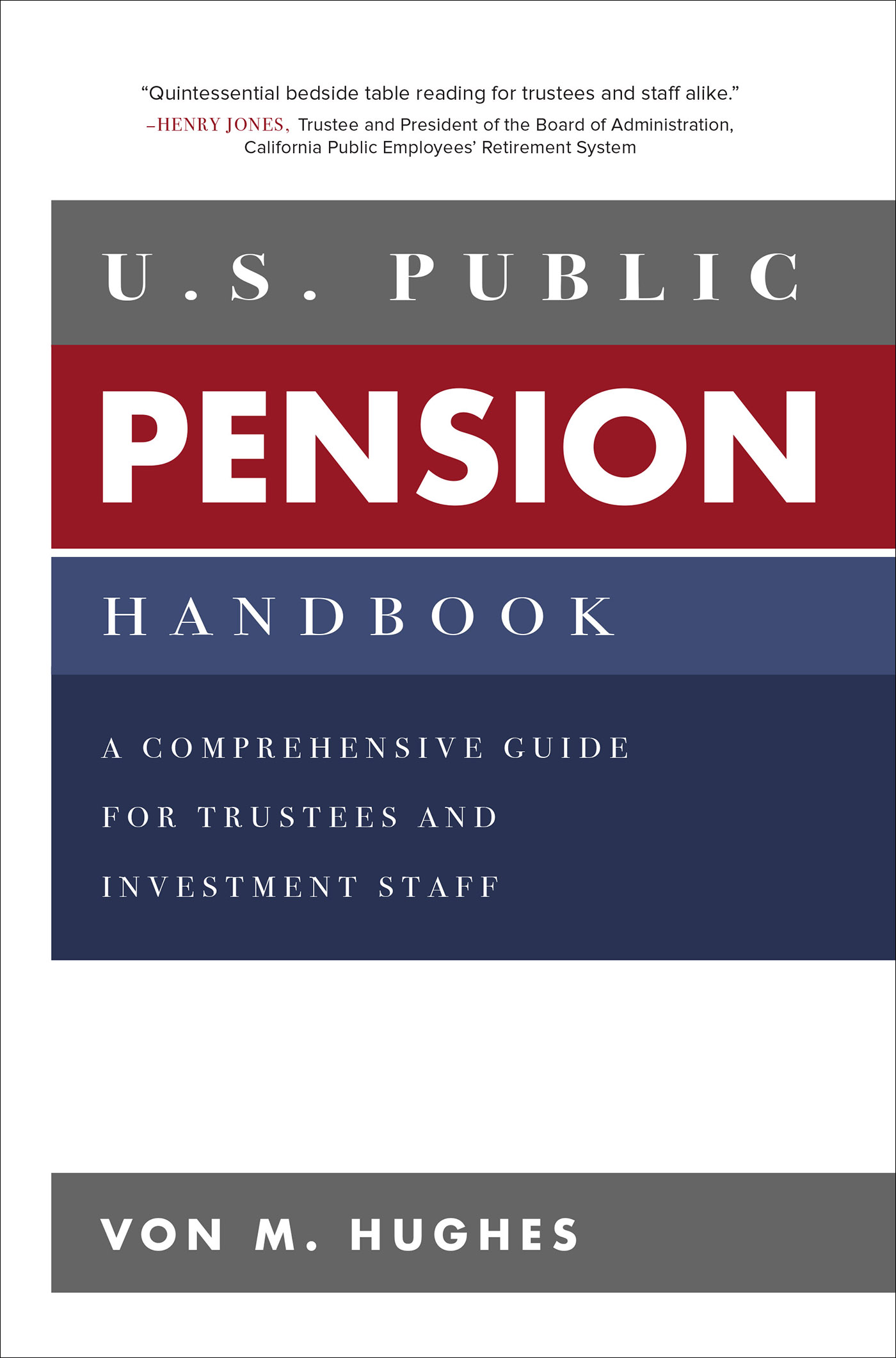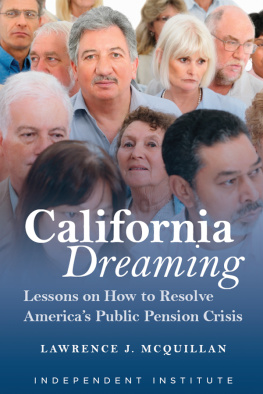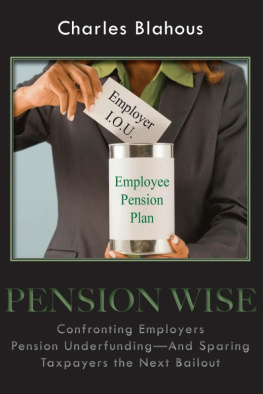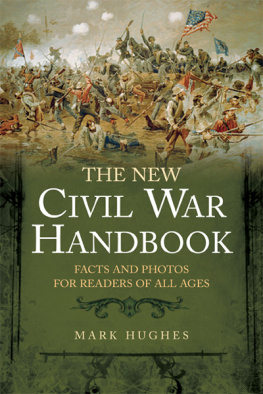Von M. Hughes - U.S. Public Pension Handbook
Here you can read online Von M. Hughes - U.S. Public Pension Handbook full text of the book (entire story) in english for free. Download pdf and epub, get meaning, cover and reviews about this ebook. year: 2019, publisher: McGraw-Hill Education, genre: Politics. Description of the work, (preface) as well as reviews are available. Best literature library LitArk.com created for fans of good reading and offers a wide selection of genres:
Romance novel
Science fiction
Adventure
Detective
Science
History
Home and family
Prose
Art
Politics
Computer
Non-fiction
Religion
Business
Children
Humor
Choose a favorite category and find really read worthwhile books. Enjoy immersion in the world of imagination, feel the emotions of the characters or learn something new for yourself, make an fascinating discovery.

- Book:U.S. Public Pension Handbook
- Author:
- Publisher:McGraw-Hill Education
- Genre:
- Year:2019
- Rating:4 / 5
- Favourites:Add to favourites
- Your mark:
- 80
- 1
- 2
- 3
- 4
- 5
U.S. Public Pension Handbook: summary, description and annotation
We offer to read an annotation, description, summary or preface (depends on what the author of the book "U.S. Public Pension Handbook" wrote himself). If you haven't found the necessary information about the book — write in the comments, we will try to find it.
U.S. Public Pension Handbook — read online for free the complete book (whole text) full work
Below is the text of the book, divided by pages. System saving the place of the last page read, allows you to conveniently read the book "U.S. Public Pension Handbook" online for free, without having to search again every time where you left off. Put a bookmark, and you can go to the page where you finished reading at any time.
Font size:
Interval:
Bookmark:


Copyright 2019 by McGraw-Hill Education LLC. All rights reserved. Except as permitted under the United States Copyright Act of 1976, no part of this publication may be reproduced or distributed in any form or by any means, or stored in a database or retrieval system, without the prior written permission of the publisher.
ISBN: 978-1-26-013477-3
MHID: 1-26-013477-6
The material in this eBook also appears in the print version of this title: ISBN: 978-1-26-013476-6, MHID: 1-26-013476-8.
eBook conversion by codeMantra
Version 1.0
All trademarks are trademarks of their respective owners. Rather than put a trademark symbol after every occurrence of a trademarked name, we use names in an editorial fashion only, and to the benefit of the trademark owner, with no intention of infringement of the trademark. Where such designations appear in this book, they have been printed with initial caps.
McGraw-Hill Education eBooks are available at special quantity discounts to use as premiums and sales promotions or for use in corporate training programs. To contact a representative, please visit the Contact Us page at www.mhprofessional.com.
This publication is designed to provide accurate and authoritative information in regard to the subject matter covered. It is sold with the understanding that neither the author nor the publisher is engaged in rendering legal, accounting, securities trading, or other professional services. If legal advice or other expert assistance is required, the services of a competent professional person should be sought.
From a Declaration of Principles Jointly Adopted by a Committee of the American Bar Association and a Committee of Publishers and Associations
TERMS OF USE
This is a copyrighted work and McGraw-Hill Education and its licensors reserve all rights in and to the work. Use of this work is subject to these terms. Except as permitted under the Copyright Act of 1976 and the right to store and retrieve one copy of the work, you may not decompile, disassemble, reverse engineer, reproduce, modify, create derivative works based upon, transmit, distribute, disseminate, sell, publish or sublicense the work or any part of it without McGraw-Hill Educations prior consent. You may use the work for your own noncommercial and personal use; any other use of the work is strictly prohibited. Your right to use the work may be terminated if you fail to comply with these terms.
THE WORK IS PROVIDED AS IS. McGRAW-HILL EDUCATION AND ITS LICENSORS MAKE NO GUARANTEES OR WARRANTIES AS TO THE ACCURACY, ADEQUACY OR COMPLETENESS OF OR RESULTS TO BE OBTAINED FROM USING THE WORK, INCLUDING ANY INFORMATION THAT CAN BE ACCESSED THROUGH THE WORK VIA HYPERLINK OR OTHERWISE, AND EXPRESSLY DISCLAIM ANY WARRANTY, EXPRESS OR IMPLIED, INCLUDING BUT NOT LIMITED TO IMPLIED WARRANTIES OF MERCHANTABILITY OR FITNESS FOR A PARTICULAR PURPOSE. McGraw-Hill Education and its licensors do not warrant or guarantee that the functions contained in the work will meet your requirements or that its operation will be uninterrupted or error free. Neither McGraw-Hill Education nor its licensors shall be liable to you or anyone else for any inaccuracy, error or omission, regardless of cause, in the work or for any damages resulting therefrom. McGraw-Hill Education has no responsibility for the content of any information accessed through the work. Under no circumstances shall McGraw-Hill Education and/or its licensors be liable for any indirect, incidental, special, punitive, consequential or similar damages that result from the use of or inability to use the work, even if any of them has been advised of the possibility of such damages. This limitation of liability shall apply to any claim or cause whatsoever whether such claim or cause arises in contract, tort or otherwise.
Id like to thank my wife Carmen for her patient support throughout the writing process, but even more so for her confident, persistent encouragement over the last few years that I had the ability and drive to make this book a reality. Id also like to thank both Christina Esquer and Justin Glen for their diligent help in collecting research and processing the volume of data that ultimately went into these pages. And, finally, Id like to thank my kids, Stewart, Gabrielle, and Alexa, whose enthusiastic and proud statements to others that my dad is going to publish a book! was all the motivation that I truly needed.
FOR OVER 16 million public employees in this country, retirement income provided by public pension systems represents the core component of their long-term retirement security. It is commonly said that retirement security sits on the stable, three-legged stool of personal savings, Social Security, and pension benefits. However, state and local government pensions in our country, an important leg of this stool, face very real challenges to their long-term sustainability. And the challenges to organizational sustainability are faced at various levels within the public pension ecosystem.
Public pensions face the demographic challenges of an aging population and an increasingly mobile workforce, and the pressure on pension designs caused by these demographic shifts. Higher life expectancy, driven by improvements in medical and public health knowledge, continue to increase long-term pension liabilities and current obligations. The defined benefit model has provided, and continues to provide, pension security for the overwhelming majority of public employees in this country. The defined benefit design has weathered and survived global wars, the Great Depression, and various recessions over the last century. The persistence of the defined benefit model itself speaks volumes to its effectiveness as a design and as a core component of retirement security in this country.
However, public pensions continue to face funding challenges. Increasing reliance on volatile market returns to meet or exceed actuarial assumptions or targets that may or may not meet long-term expectations or liabilities puts pressure on public pension trustees and investment staffs. Pension design does matter. And pension reform has highlighted a number of alternatives to the defined benefit model, including defined contribution, hybrid, and other pension designs. Yet the most common and impactful public pension design shifts continue to be not away from the defined benefit model but toward an adjusted defined benefit model. For example, public pension trustees have responded by lowering long-term pension costs by increasing the age or vesting requirement for benefit eligibility, or even increasing the number of years used to calculate final average salary in the defined benefit formula. More dramatic pension design shifts to fully defined contribution (or even meaningful hybrid) models are far less common across the public pension landscape than modifications to the durable, persistent defined benefit model. However, thoughtful public pension trustees should continue to explore and discuss innovative approaches to reducing pension costs.
Public pension trustees also face challenges to organizational sustainability in the marketplace for investment talent. As public pension portfolios become more complex and the investment approaches employed become more sophisticated, state and local pensions feel the heat of competitive pressure from the private sector to hire and retain qualified investment professionals. The need for qualified investment professionals with specialized investment expertise has only become more pressing as current public pension governance encourages and often requires effective delegation to staff. Moreover, the burden on investment staff has increased as well. Public pension staff is commonly asked to shoulder increasing workloads, as public pension internal resources often do not match what is needed to meet established public pension portfolio goals. Trustees must be vigilant to prevent this mismatch, by either increasing internal staff in a competitive marketplace for investment talent or by simplifying portfolio goals to match resource and investment talent constraints.
Font size:
Interval:
Bookmark:
Similar books «U.S. Public Pension Handbook»
Look at similar books to U.S. Public Pension Handbook. We have selected literature similar in name and meaning in the hope of providing readers with more options to find new, interesting, not yet read works.
Discussion, reviews of the book U.S. Public Pension Handbook and just readers' own opinions. Leave your comments, write what you think about the work, its meaning or the main characters. Specify what exactly you liked and what you didn't like, and why you think so.











